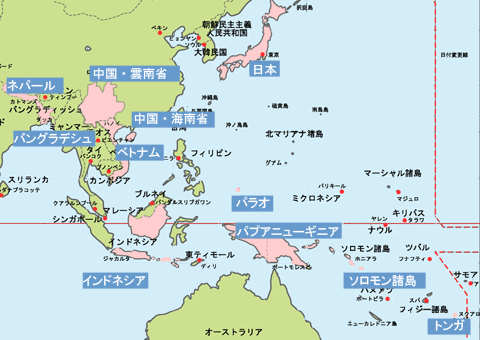
Most of our researches fell into the field of “Environmental Health” and/or “Population biology [of human]”, and we utilized both fieldwork and experimental approach. Most of our study fields were Asian-Oceanian rural communities, focusing on population, nutrition/growth, and environment. Experimental studies focusing on the effects of perinatal exposures to heavy metals have been conducted, emphasizing the factors that modify the effects. What follows is a list of major projects conducted in the past two years.
1. Neurodevelopmental effects of perinatal exposure to environmental chemicals:
Modern human societies, regardless developed or developing, consume and are exposed to a variety of chemical substances, which would be regarded as a substantial part of the environment. Since often the fetus/newborn is relatively sensitive to these chemical substances, we focused the exposure to chemicals during perinatal period. Collaborating with several institutes/universities, we have conducted studies on the effects of heavy metals (mercury and cadmium), toxicity of which were still being debated in Japan and other countries, as well as of so called endocrine disrupting chemicals. Toxicity was evaluated at cellular as well as organism levels, and major findings included susceptibility of metallothionein knock-out mice to the neurodevelopmental toxicity of metals, and demonstration of developmental neurotoxicity of low-dose of cadmium. Another experimental study regarding the interaction between selenium and arsenic was conducted, hinted by our field study finding; effects of thyroid hormones as well as mutual modification of the kinetics were found.
2. Water and air quality and health in developing countries:
In many Asian and Latin American countries, pollution of groundwater has been a serious problem for health. We have conducted surveys in Bangladesh, where a large-scale groundwater contamination by arsenic pauses serious threat. We have extended this survey to Nepal, confirming our previous findings of males’ susceptibility to arsenic, and demonstrated the mutual relationship between malnutrition and arsenic toxicity. In Indonesia, we have started a study on water pollution by pesticides, metals, and others, the final goal of which is to evaluate the effects of contamination on children’s health. A survey of water quality has been conducted as the first step. Air pollution in the developing countries is another vexing environmental issue, especially in Asian urban areas. Body burden of lead (Pb) in bus terminal workers in an Indonesian city has been examined; possible modification of body burden by nutritional status was shown.
3. Studies on nutrition, growth, and physical activities (energetics) in developing countries.
Nutrition is one of the fundamental requirement for health and is especially important in developing countries. In rural Bangladesh, food consumption, nutritional status, and activity of the villagers were examined; distinct gender-related difference was found. In rural Western Java, Indonesia, the relationship between the nutritional status during the preadolescent period and biological parameters at birth were analyzed. In Tonga, where the prevalence of obesity is high, anthropometry was conducted for adolescent girls, and factors associated with obesity were identified. In the schoolchildren of rural China, prevalence of the infection with schistosomiasis was examined and the relative importance of the parasite infection and nutritional status for the physical growth of the children was evaluated. Physical activity and energetics are important not only from the viewpoint of Human Ecology but also from the prevention of lifestyle-related diseases. Our focus has been on the energetics of the people living in their daily life. In Papua New Guinea, it was examined how the domestic migration from rural villages to urban area changed the physical activity of the people. Also, the energetics of Sumo-wrestlers were characterized.
4.Development and subsistence activity, subsistence transition and adaptation:
In many Asian and Oceanean countries, various types of developmental projects have been undertaken aiming at economic development, procurement of natural resources, or accelerating tourism. Such developmental projects brought about drastic changes in the subsistence activity of people, availability of natural resources, or ecosystem, and in turn, caused changes in lifestyle and health status, disease patterns of the people. Attempts to describe such changes were made in China as well as Solomon Islands. Adaptive strategy at household level was analyzed in China, where subsistence transition has been taking place, and possible determinant of the difference in the strategy was identified. In some studies, Geographical Information System (GIS)/GPS was used for analyzing the relationship between the subsistence transition and land-use.
Research places of Human ecology

We have a meeting on every tuesday from 16:00 until about 19:00, where 2 members of the department introduce recent studies of
related discipline in English. Person who wants to attend
may contact with the staff.
